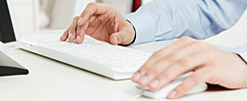

THE LONG AND SHORT OF FOREX TRADING
11th June 2019
When traders open a new position, they either go long or they go short. So, what is long and short in trading? This post explores the concepts of buying, selling, and going long or short in detail.
The three trading positions
There are three potential positions you can have for an asset – a long position, short position, or no position. And to end up with one of those positions, there are four types of trades you do. That’s right, buying is not always the same as going long, and selling is not always the same as going short.
If you have no position in the USD/EUR pair and you buy it, you are opening a long position because you now own USD. However, if you were short of USD/EUR and you bought the same amount, you would end up with no position. So, although you are buying you are not opening a long position. Buying to close a short position is known as covering a position while closing a long is known simply as closing. So, you can buy long, sell short, buy to cover or sell to close.
If you start with a long position and you sell that position, you’ll have no position. If you then sell the same quantity again, you will have a short position.
Forex vs other markets
The concept of going long and short is slightly different for forex markets when compared to other markets. For stocks, bonds, and commodities, when you go long or buy, you are doing so in a specific currency. Usually, this will be the local currency, or for global markets like gold or copper, it will be in US Dollars. It’s exactly like buying a car, mobile phone or meal, except that you are doing so because you think the price will rise and not to use or consume the product. In most cases, there is only one price you are looking at and you expect that price to rise.
You can also go short of equities, bonds, and commodities if you believe the price will fall. However, going short is slightly different, because you can’t sell something you don’t own. To sell one of those instruments short, you must first borrow the same quantity that you want to sell short. In return, you pay the lender a fee, much like an interest rate. You now have a short position, but you owe the stock to the lender – this is why it’s known as being short. When you cover your short, you give the stocks or bonds back to the lender, and you then have a flat position
CFDs (contracts for difference) and futures are slightly different. Because they are just contracts, there is no actual asset to hold or borrow. You will still have a long or short position, but you don’t have to borrow contracts to sell them short.
Now we come to the forex market. Currencies are priced in other currencies. You can buy USD priced in EUR, JPY, AUD or almost any other currency, and in each case, the price will be different. The other difference is that you can never just go long of one currency without also going short of the currency it is priced in.
If you are long USD/EUR, you have a long position in USD and a short position in EUR. You will make a profit if the USD goes up more than the EUR, or if the EUR goes down more than USD.
In the case of currencies, you don’t have to borrow, because you own one asset and you are pricing it using the second asset. So, although you are short the second asset, you don’t need to borrow it to sell it short.
When to go long of a currency
Long term traders and investors base their decisions on fundamentals. These are the factors that affect the value of an asset which ultimately will determine its price as well.
If interest rates are expected to rise, a currency may appreciate as investors buy the currency to earn higher yields. If a country exports more than it imports, more capital will have to flow into the country. If someone in the US imports something from Japan, they will have to buy Japanese Yen, so if that happens on a large scale the Yen will appreciate.
If one country is expected to grow faster than another country, capital for investment will flow into that country. If the stock and bond markets are expected to be strong, this will also lead to capital flows and a rising currency.
Short term traders base their decisions on supply and demand because that is what affects the price in the short term. These decisions are usually based on technical analysis. A currency may rise if there is strong momentum attracting momentum and trend traders, or if a major resistance level is broken. A currency will also often rise in the short term if it is oversold.
Finally, changes in sentiment, which can be caused by political or economic factors, can cause a currency to rise.
When to go short of a currency
As you already know, going long of one currency means you are going short of the other currency in the pair you are trading. However, sometimes your reason for buying the pair will be based on the fact that you are wanting to short the second currency in the pair.
Again, long term fundamentals are used by long term investors. Slowing growth and rising inflation can lead to currency weakness. If a country has rising debt and is expected to sell more bonds that can also cause the currency to weaken. Rising risk due to political or economic factors can also lead to a weaker currency over time. If imports exceed exports, more capital will flow out of a country, and its currency will weaken.
In the short term, risk aversion can lead traders to dump the currencies of emerging markets. Negative momentum can also cause momentum traders to short a currency, especially if a major support level is broken.
Summary
Unlike other markets, any forex trade involves buying one currency and selling another. So, currency trade is in many ways a long and a short trade.
There are many factors that cause currencies to rise and fall, and traders should understand them all and how they all fit together. This is what makes the currency markets so interesting – economics, politics, and social factors all come into play, along with the relationships with other markets. It is highly recommended that new traders spend time increasing their knowledge and understanding of the factors that cause currencies to rise and fall.
All content is provided for your information only.
This article may contain opinions and is not advice or a recommendation to buy, sell or hold any investment. No representation or warranty is given on the present or future value or price of any investment, and investors should form their own view on any proposed investment. This article has not been prepared in accordance with legal requirements designed to promote the independence of investment research and is considered a marketing communication. Non-independent research is not subject to FCA rules prohibiting dealing ahead of research, however we have put controls in place (including dealing restrictions, physical and information barriers) to manage potential conflicts of interest presented by such dealing.
One Financial Markets expressly disclaims all liability from actions or transactions arising out of the usage of this content. By using our services, you expressly agree to hold One Financial Markets harmless against any claims whatsoever and confirm that your actions are at your sole discretion and risk.
Begin trading today! Create an account by completing our form
Privacy Notice
At One Financial Markets we are committed to safeguarding your privacy.
Please see our Privacy Policy for details about what information is collected from you and why it is collected. We do not sell your information or use it other than as described in the Policy.
Please note that it is in our legitimate business interest to send you certain marketing emails from time to time. However, if you would prefer not to receive these you can opt-out by ticking the box below.
Alternatively, you can use the unsubscribe link at the bottom of the Demo account confirmation email or any subsequent emails we send.
By completing the form and downloading the platform you agree with the use of your personal information as detailed in the Policy.






